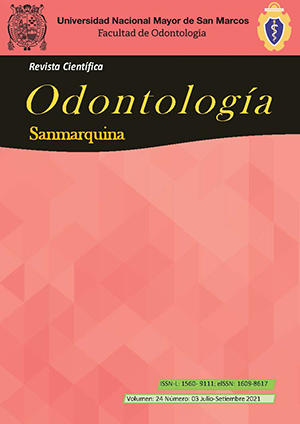Oral health indicators in children and adolescents with cerebral palsy from specialized centers of Lima- Peru, 2012- 2013 period
DOI:
https://doi.org/10.15381/os.v24i3.20714Keywords:
Cerebral palsy, DMF index, Malocclusion, Oral hygiene index, (source: MeSH NLM)Abstract
Objective. To evaluate oral health indicators in children and adolescents with cerebral palsy in Lima-Peru. Methods. An observational, descriptive and cross-sectional study of a sample of 171 patients from two specialized national referral centers for the 2012-2013 period who met the inclusion criteria. For the Greene & Vermillion oral hygiene index (OHI), decayed, missing and filled teeth (DMFT) and the dental malocclusion (DM) analysis, 126 children (6.0-11.9 years-old) and 45 adolescents (12.0-19.0 years-old) were evaluated. Results. The OHI was 2.55 (poor hygiene) in the 91.8%, regular OHI in the 8.2% and no one showed a good IHO, observing the same behavior in both age groups. The prevalence of caries was 100% and the DMFT was 4.55 ± 1.56; the children registered a DMFT of 4.52 ± 1.537 and the adolescents 4.64 ± 1.626. The DM was present in 74.3%; the children showed a 69,8% of DM and the adolescents showed 86.7%. In children, a right class I molar relationship (MR) was observed in 42.1% and a left MR in 44.4%; the adolescents showed right Class III in 42.2% and left in 37.8%. In children, the overbite (OB) was not registered in the 33.3% of the cases and it was normal in the 29.4%; the adolescents registered a normal OB in 40%. It was more frequently observed a deviation of the dental midline to the left. Conclusions. In most children and adolescents with cerebral palsy from specialized centers, a high index of DMFT caries, poor oral hygiene and the presence of malocclusions were found.
Downloads
Downloads
Published
Issue
Section
License
Copyright (c) 2021 María Angélica Alvarez-Páucar, María del Rocío Lu-Chang Say, Roxana Revoredo-Morote

This work is licensed under a Creative Commons Attribution 4.0 International License.
AUTHORS RETAIN THEIR RIGHTS:
a. Authors retain their trade mark rights and patent, and also on any process or procedure described in the article.
b. Authors retain their right to share, copy, distribute, perform and publicly communicate their article (eg, to place their article in an institutional repository or publish it in a book), with an acknowledgment of its initial publication in the Odontología Sanmarquina.
c. Authors retain theirs right to make a subsequent publication of their work, to use the article or any part thereof (eg a compilation of his papers, lecture notes, thesis, or a book), always indicating the source of publication (the originator of the work, journal, volume, number and date).






